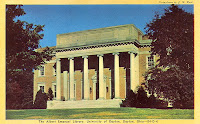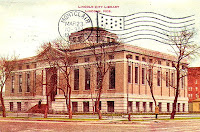Low Memorial Library was constructed in 1895 as the architectural center of the Morningside Heights campus, and named for Seth Low, a former president of the university. The building
housed the campus library until 1934, and today serves as the location of the office of the president and the Columbia archival collection, as well as the site for the annual awarding of the Pulitzer Prizes.
The Library was designed by the architectural firm of McKim, Mead, and White,
which was responsible for the design of much of Columbia's Morningside Heights campus.
The steps leading to the library's columned facade are a popular meeting place for Columbia students, as well as home to Daniel Chester French's sculpture, Alma Mater, a university symbol.
Designed in the neo-classical style, incorporating many of the elements of Rome's Pantheon,
the columns on the library's front facade are in the Ionic order, suited to institutions of arts and letters. The 106-foot tall rotunda, formerly the library reading room when the building was used for its original function, is lined with columns of solid green Connemara marble from Ireland, topped with gold capitals.
Low Library's location, atop a plinth of stairs at the centre of campus, was meant to demonstrate the value of the secular pursuit of knowledge as opposed to religion, the role of which was minimised via the subsidiary placement of the university's religious buildings on Low's right and left flanks.
The first building on Columbia's new Morningside campus when it was built in 1895, rising out of cropfields, Low originally served as the university's main library, a role which ended when it was supplanted by the larger Butler Library in 1934, and it now only holds the university's archives in addition to its administrative offices. In 1954, during the University's bicentennial, Low Library was commemorated on a postage stamp.
 [LIB3415] 1915 postcard.
[LIB3415] 1915 postcard.












































